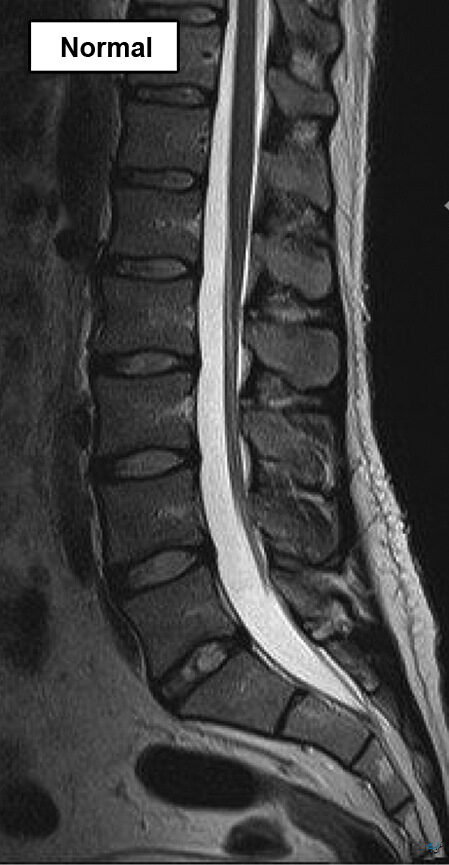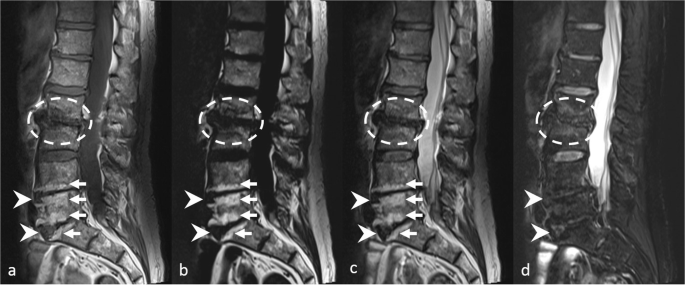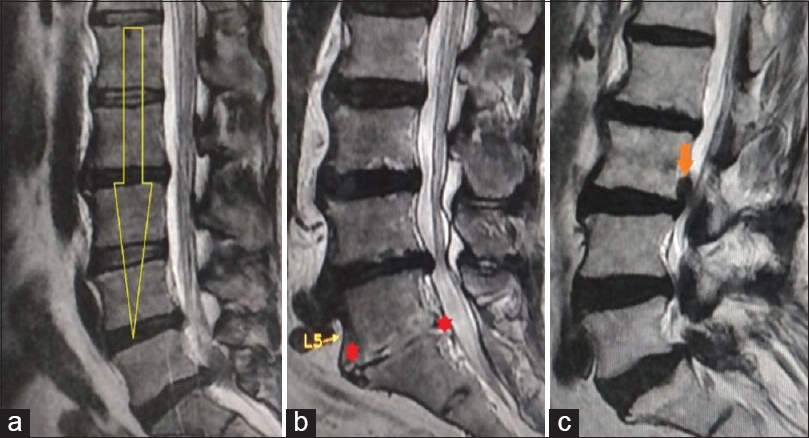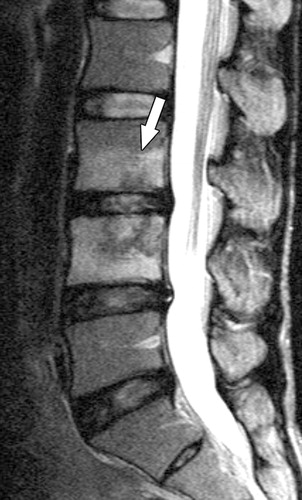Back MRI + Lumbar MRI Turn
Low back pain and sciatica are one of the most common health problems. Almost everyone has back pain during a period of their lives. Interestingly, in most cases, the exact cause of pain cannot be found. Lumbar MRI is a medical imaging technique that creates detailed images of soft tissue around the spine. In this article, we have a percenter to familiarize you with the generalities of lumbar MRI and also show you the method of taking the lumbar MRI in the simplest way possible. So stay with us to the end.
Most patients and doctors may be concerned that a serious factor is causing low back pain. Can low back pain be caused by cancer or infection in the spine? How to know the cause of low back pain.

In the figure above, the image is shown as a normal MRI. If your back MRI is something like the shape above, then don’t worry at all. If you have one of the following symptoms with low back pain, lumbar MRI should be done:
- Cannot excrete urine or feces painlessly.
- You can’t control your urine or your stool.
- You have difficulty walking and balancing.
- Low back pain that is severe in children.
- Fever
- History of cancer
- Other signs or symptoms of cancer
- Falls or serious injuries
- Low back pain that is very severe and even pain pills don’t help
- One leg feels numb or faint and is getting worse
If you have back pain but do not have any of the warning signs mentioned, it is not necessary to do lumbar MRI.
Keep in mind that:
Most of the time, back pain and neck pain are not caused by a serious medical problem or injury.
Back pain or neck pain often heals spontaneously over time.
The lumbar MRI creates detailed images of your spine. These images can show most of the damage you’ve had in your spine or the changes that happen with age in extraordinary detail. In MRI images, even small problems or changes that are not the cause of your current back pain are also identified. These new findings could lead to your doctor prescribing more tests.
You are more concerned about your health and your waistline. If these concerns cause you not to exercise, it may take longer for your back to heal.
But let’s go a little more closely on the reasons for prescribing a lumbar MRI. Medical professionals perform lumbar MRI for a variety of reasons. If a person feels pain in their lower back area, your doctor may recommend a lumbar MRI scan to help diagnose the source of the pain.
Low back pain: Back pain caused by muscle strain, joint damage or other reasons.
Sciatica: This causes acute pain and is caused by nerve root stimulation, possibly due to inflammation or structural changes.
Limping: Limping can lead to movement problems and vague pain or pain in the lower extremities. Limping can also be caused by a vascular that affects blood vessels or is a nerve that involves the nerve network.

Your doctor may also prescribe lumbar MRI for a person who is scheduled to undergo back surgery. In this case, the surgical team uses lumbar MRI results to help plan the operation.
Waist MRI is a powerful diagnostic tool that doctors may use for:
- Evaluation of spinal alignment and balance
- Diagnosis of vertebral or spinal cord abnormalities
- Check the herniation of the lumbar disc, which can lead to leg pain.
- Evaluation of any inflammation of the spinal cord or nerves
- Evaluation of tumor on or around the spinal cord
- Monitoring spinal injury after the accident
- Postoperative monitoring of the spine
- Investigating the different causes of low back pain

Your doctor usually does not have a back MRI during the first 6 weeks when a person is experiencing pain, unless the person has:
- Sudden low back pain that occurs with fever
- Injury or trauma
- Sudden low back pain is associated with spinal sensitivity, which is possibly associated with cancer, osteoporosis or steroid use.
- Bowel or bladder incontinence
- A serious underlying disease, such as cancer
The reason for the delay in lumbar MRI is that most cases of low back pain are resolved within a few weeks. Disc herniation is usually re-absorbed within 8 weeks. Performing lumbar MRI very early can lead to unnecessary costs and anxiety.
Interpretation of Kemer MRI
Interpretation of lumbar MRI is a highly specialized work that should be done by a radiologist. But in Ibn Ja, we want to briefly tell you the answer to the MRI Kemer. A lumbar MRI can indicate the reason a person is experiencing back, calf or other types of pain.
Lumbar MRI can show the following symptoms:
- Congenital or developmental disorders, a characteristic that a person has developed or had since birth.
- Degenerative changes, such as a broken disc or disc herniation, called an annular fissure.
- Inflammation or infection
- Benign or malignant tumor
- Central vertebral canal stenification, leading to nerve compression in the spine.
- Ankylosing spondylitis that may include inflammation and deformity of the spine
- Spondylolistsis, in which the vertebrae slips out of place and affects the alignment of the spine (lumbar disc).
- Other changes, such as abscesses
There is no need to take action if the image is normal.
What’s striking is that no diagnostic technology is entirely reliable, although some studies have suggested up to 100 percent success rates for lumbar MRI that detects disc herniation.
An MRI does not conclusively indicate that a person has a particular problem, and as a result, the person may need further tests. In addition, there is a possibility of a false positive result, where the scan shows that there is a problem while.
Lumbar MRI duration
The duration of lumbar MRI is usually 15 to 90 minutes. The time of lumbar MRI depends on where the person performs the scan and what kind of images he or she takes from the waist. After an MRI scan, a person is usually free to go home and continue their daily routines.
After lumbar MRI, the radiologist interprets the results. The lumbar MRI answer usually takes 2 to 3 days to show up. This period depends on the MRI center where you have done the MRI. The radiologist at the center writes a report to send to the person’s doctor. The doctor will then share the findings with the individual.
In general, it can be said that lumbar MRI is one of the most common MRI scans. To do A-lumbar MRI, you need to take turns from a center. To do this, you may need to go to the MRI centre in person and take turns, which is usually difficult. In scanning an online platform, we have provided medical imaging appointments so that compatriots from all over the country can take turns shooting. Therefore, you can get a lumbar MRI from any city you live in for free.







